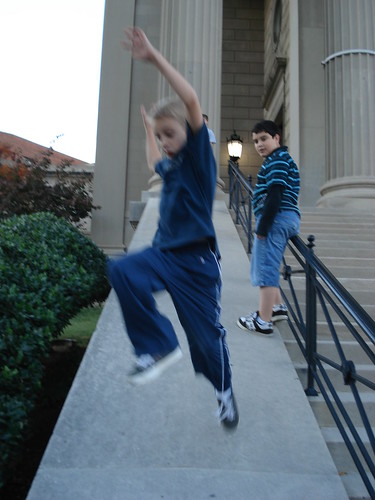It got me thinking about what I would recommend as a goal for an animation student, and I think I stumbled across something that creates one of the biggest differences between the work of students and professional animators. There is quite a gap, and the change when you get your first job it quite dramatic.
My first job was at Disney (Sydney Australia) where they were setting the highest standard for animation in the country at the time and pushing it even higher as they made the transition to feature length films. Almost overnight my attitude towards work was totally renovated, suddenly I was working my ass off at a higher quality of work than I couldn't possibly have imagined before. So what happens, why is this sudden lift in the work standard possible. Its not because my knowledge of animation principles changed that much (making an intentional distinction between knowledge of and understanding of ), its more immediate than that. I think a large part of the difference is that students (and teachers) often give themselves permission to call a piece of animation finished so they can move on far too early.
You see in a workplace the studio has agreed to supply animation that meets certain criteria, standards are met and there is absolutely no debate, even seemingly subjective elements of the work have usually been defined in advance in order to secure the contract. There is no hiding behind “style” or “personal taste”, it has to look how it was promised it would look or there is going to be a serious problem. Try to get some work past your supervisor that does not meet that standard then you will find your self being sent back to do it again. Its never a case of, we will address those things next time.
I have first hand experience of three different educational institutions and have never seen these conditions reproduced for an animation student. In some ways perhaps they can't be, or shouldn't be, but I think there is room to move in this direction. Lets look at a simple example, I can see from the blogs that another good activity set for the second years upon their return was to revisit a bouncing ball exercise, a good quicky to get you back in the swing of things. I would bet that a percentage of the people who have animated a bouncing ball haven't quite captured the real feel of something with weight, what percentage I wonder. How many really have the feel of a bouncing ball, be honest, I mean really feel like the real thing, 80%.... 50%....(eeek)25%. And yet, everyone will move on to the next thing. Just wouldn't happen in a workplace.
So we are dealing with some sensitive stuff here aren't we. A percentage of the people in any animation course (and I mean any course) just aren't going to get good enough to have a future in the trade. What they do learn may come in handy in other work, and they have paid their fees so its not like they don't deserve or have the right to be there. If a percentage of students just aren't going to get it for one reason or another then we can't stop everyone's progress until it gets through. Even excluding the students with no future as animators, everyone learns at different speeds and there are some who would be equally short changed by the lack of progress.
So the system isn't perfect, and I've beaten my head against that system and am not going to encourage anyone else to go through the same. What can be controlled however (believe it or not) is what's going on inside your head. Your goals need to be more than vague ideas of what you want, you can strive to make them as solid and rigid as they would be in a workplace.
Don't let yourself move on unless you have nailed something. Simple right? NOT!
For starters your class is going to be plodding along at the speed your teacher thinks best suits the skill level of the group, you don't control when the class has to move on to the next thing. The next thing is how do you know when you have nailed something, at some stage your teacher is going to have to say its time to move on, and as covered it may be before you have really got it right (don't blame them, they are just doing their best within the structure, something you will have to do when you are working at an animation studio too).
The first problem is the simplest to solve, but perhaps not the easiest. Here it is, You Just Have To Find The Time. I see students choose to put other things in front of their animation all the time (sport , a domestic duty of some kind, a social engagement, etc. etc.), and who am I to tell you how to live your own personal life. No-one and that's that. But I have a simple fact for you to consider....
If you don't find this time somehow, you have no future as an animator*.
If you need to spend some extra time on something before moving on then you have to find that time within your life. I can't put it any simpler than that.
I guess there are many ways to come at the second issue, you could ask a professional animator for their opinion or use the best of your class mates as a benchmark. But I have another idea that I think is better. Find a video example of something similar happening that is either live action or a piece of animation that you hold in very high regard, when you are testing your animation constantly compare it with your chosen benchmark until it is as good or better. I don't mean use live action reference (although you can if you want), how you animate is not what this post is about, I mean compare the level of weight, emotion, timing, spacing and polish you produce with something great. Get them side by side, even flicking through the frames of each one at a time, until your animation matches the quality and feel of the piece you have chosen for comparison. Leave as little as possible to subjectivity, match the resource and don't allow yourself any excuses. Did you know Youtube have added a new download feature, there is so much reference material there (animated and live action) there is no excuse.
So to boil it down, setting goals is good, but don't just set goals, set standards for your work too and set them high, friggin high!! So high that you end up flying. ........ Or is that falling with style ;)

Toy Story Image from the awsome blog of Karen J Lloyd
* - I guess its this kind of stuff that gets me labelled a pessimist as mentioned in this post, but its just the way things are! Wouldn't you rather know where you stand.
UPDATE - Right on cue, check out this post on planning from Carlos Baena, see how he finds footage to refer to. He is setting a standard for himself, its exactly what I mean :) Along with this one I have found quite a few new resources of late and will upload some new links if I have time this weekend.




6 comments:
hahaha, falling with style ^-^
Thanx for this blog Ian, puts a few good things into perspective for me :)
It's weird without you at tafe, I hope you'll find the time sometime this term to come in and say hi.
Hi Mitch!
Thanks for commenting, and glad your finding the ARC usefull :)
I do plan to visit for sure.
Hey Ian good post once again. It's great as an animation teacher to have an industry animator (and one of the best animation educators on the wibbly wobbly) making important, timely posts on relevant issues.
It is animation gold having good discussions with students and having the back up to say, "... and I want you to read this post on the ARC."
As for the bouncing ball exercise, who said there was just one? As far as I'm concerned those students are going to be bouncing balls until they turn purple (with rage - you should have seen Brendan's smile when I said he was going to be doing bouncing ball exercises over and over)!
As the class whips through the basic modelling and rigging, the bolters will have ball exercises that will mean something and be applicable to their future character rig EAPs. :)
Bounce those balls!
can o' worms. 1) competition is fierce "while you sleep your enemy trains 2) gotta have time for a life or else won't have anything to pull from for your animation 3) get pro by pushing yourself for high standards 4) if you are still struggling with the whole idea maybe you would learn faster starting a new project right
I know that personally I spent a few months beating my head against a wall trying to bring full body stuff to a high polish before I was really comfortable with the computer as a tool.
I'm reminded of the pottery class story, class divided in 1/2, one side is told to make quantity as many pots as they can, the other side told to just 1 perfect pot. So the perfect pot side talks and theorizes about it, but at the end of the term the side that had the most practice just doing it had the more perfect pots.
If I were to do it over again I would focus on short short projects. Like a new quick bouncing ball every day, or ball with tail, or pendulum, or ball with 2 legs. 100 frames or less. The point being you can start and finish the project within an hour or less. Like daily exercises. That way you're building animator muscles even if you are struggling with advanced stuff in class, and the simple projects will help keep your confidence up.
Hey Alonso
Thanks for your comments. It is really good that an animator with experience helps the discussion along.
You have described what the aim will be. That is to do many pots (bouncing balls), especially for the animators who get their character modelled and rigged quickly but properly, in the 3D classes that we're doing.
Hi Alonso
Thanks so much for your insights. I fully agree, although my experience is that students rarely need reminding that they have to make time for a social life ;)
One of my new favourite sayings is that the learning of animation is in the doing of it. Some students will spend 75%ish of their time thinking about what they are going to do before they do it (as aposed to planning it which is different), usually its better to just do something, if its a mistake you can learn from that too :)
Post a Comment